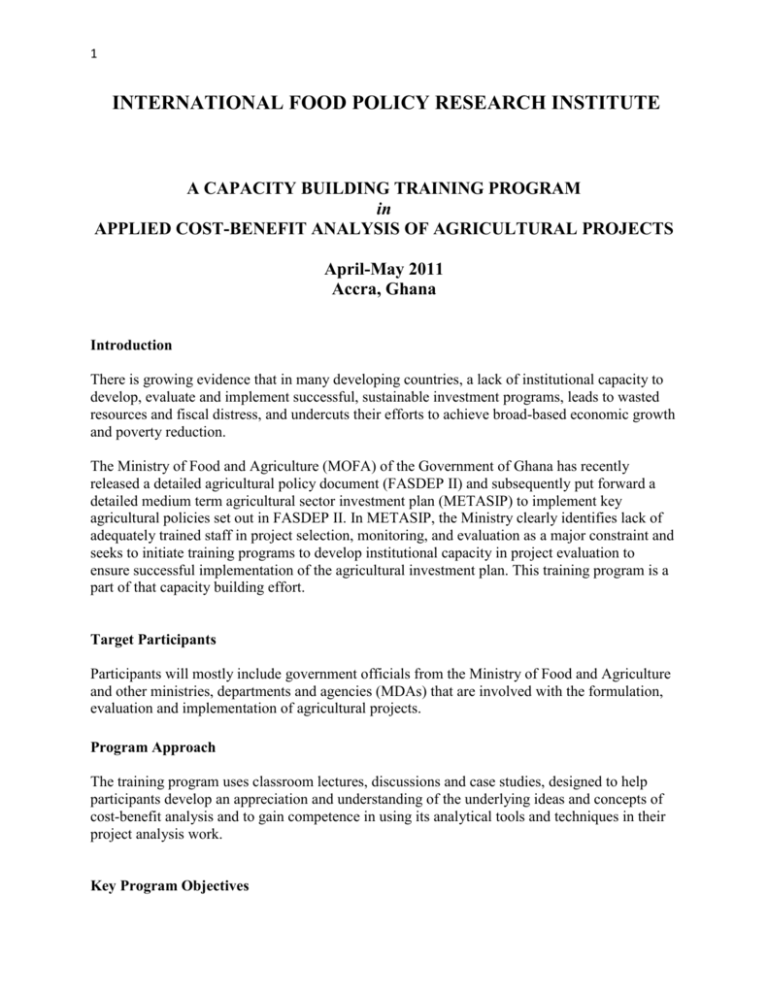course program
advertisement

1 INTERNATIONAL FOOD POLICY RESEARCH INSTITUTE A CAPACITY BUILDING TRAINING PROGRAM in APPLIED COST-BENEFIT ANALYSIS OF AGRICULTURAL PROJECTS April-May 2011 Accra, Ghana Introduction There is growing evidence that in many developing countries, a lack of institutional capacity to develop, evaluate and implement successful, sustainable investment programs, leads to wasted resources and fiscal distress, and undercuts their efforts to achieve broad-based economic growth and poverty reduction. The Ministry of Food and Agriculture (MOFA) of the Government of Ghana has recently released a detailed agricultural policy document (FASDEP II) and subsequently put forward a detailed medium term agricultural sector investment plan (METASIP) to implement key agricultural policies set out in FASDEP II. In METASIP, the Ministry clearly identifies lack of adequately trained staff in project selection, monitoring, and evaluation as a major constraint and seeks to initiate training programs to develop institutional capacity in project evaluation to ensure successful implementation of the agricultural investment plan. This training program is a part of that capacity building effort. Target Participants Participants will mostly include government officials from the Ministry of Food and Agriculture and other ministries, departments and agencies (MDAs) that are involved with the formulation, evaluation and implementation of agricultural projects. Program Approach The training program uses classroom lectures, discussions and case studies, designed to help participants develop an appreciation and understanding of the underlying ideas and concepts of cost-benefit analysis and to gain competence in using its analytical tools and techniques in their project analysis work. Key Program Objectives 2 The training program is expected to help participants achieve the following intended objectives: Develop an understanding of the key economic concepts and ideas that underpin project evaluation and to appreciate its multi-disciplinary approach. Competently conduct project analysis (involving financial, economic, and risk analysis) and to use this analysis to select public investment projects in the agricultural sector that enhance economic growth and reduce poverty. Use project evaluation techniques to select agricultural projects that can be profitably undertaken with private sector involvement and thus contribute towards private sector – centered agricultural growth, a key component of the Government of Ghana’s current agricultural development policy. Effectively communicate the project appraisal results and their implications to decision makers and other stakeholders. Use the project appraisal competence gained to aid in the prudent selection and successful implementation of various agricultural projects under the medium term agriculture sector investment plan (METASIP). Course Materials and Resources The main teaching materials to be used for the course are listed below. Most of these materials will be placed on a dedicated website for easy online access by the participants. Lecture Notes/Power Point Presentations “Economics of the Public Sector”, Joseph Stiglitz; 2nd Edition, W.W Norton, 1998 “Economic Analysis of Agricultural Projects”, J. Price Gittinger; 2nd Edition, World Bank, 1982. “ Handbook of Economic Analysis of Investment Projects”, Pedro Belli et al; The World Bank, 1998. “The Economics of Project Analysis: A Practitioner’s Guide”, William Ward and Barry Deren; The World Bank, 1995. “Food and Agriculture Sector Development Policy (FASDEP II)”, Ministry of Food and Agriculture, Government of Ghana, August 2007. “Medium Term Agriculture Sector Investment Plan (METASIP), 2011-2015”, Ministry of Food and Agriculture, Government of Ghana, September 2010. 3 COURSE CONTENT 1. Introduction and Overview a. Cost-Benefit Analysis (Project Appraisal) as an essential tool for sound fiscal management and for ensuring broad-based economic growth and poverty reduction; Importance of developing sustainable institutional capacity for conducting sound project appraisals. b. A brief overview of Ghana’s agriculture sector and its proposed policies and programs for sector modernization and development. Readings: “Food and Agriculture Sector Development Policy (FASDEP II)”, Ministry of Food and Agriculture, Government of Ghana, August 2007. “Medium Term Agriculture Sector Investment Plan (METASIP), 2011-2015”, Ministry of Food and Agriculture, Government of Ghana, September 2010. c. An overview of the approach, structure and content of the workshop. d. Selection and a brief discussion of individual or group case studies that the participants will bring with them and would work on to complete during the workshop. A wide variety of case studies will likely be selected. 2. Background Subject-Matter refresher a. Economics: supply, demand, elasticities, competitive markets, utility functions and indifference curves; graphical analysis b. Welfare analysis: Pareto efficiency, fundamental theorems, consumer and producer surplus, efficiency-equity tradeoffs in distorted markets c. Elementary Statistics: probability, cumulative probability distribution functions, concept of risk and its measurement, statistical mean, variance, and correlation coefficient d. Accounting and Finance: Financial statements, ratio analysis, time value of money, discounting and compounding, calculating NPV and IRR, portfolio theory and risk diversification 4 e. MS Excel/Spreadsheets. Entering and manipulating data; use of relevant functions, such as PMT, NPV, IRR. 3. Project Appraisal : An Integrated Framework a. Stages of Project Development Cycle: identification, preparation, appraisal and selection, implementation and monitoring, ex-post appraisal and impact evaluation b. Main Project Appraisal Components Financial Analysis Economic Analysis Risk Analysis Distributional or Gainers-Losers Analysis Private Sector Participation (PSP) Analysis Fiscal Impact Analysis 4. Financial Analysis a. construction of financial cash flow statement for the project: nuts and bolts b. incorporating inflation in financial analysis; estimating financial cost of capital to be used as the financial discount rate. c. Developing financial analysis spreadsheet and calculating financial NPV and IRR to assess project financial profitability d. Two key uses of financial analysis: 1. To assess whether the project would be financially sustainable i.e., if adequate funds will be available to fund the project through its investment and operating stages and whether it will generate enough cash flows to meet its debt repayment obligations; 2. To assess whether the project can be profitably undertaken in the private sector without any government subsidies e. Discussions of financial analysis based on an illustrative case study 5. Economic Analysis a. Rationale for Economic Analysis: Market failures and Government failures b. Market or Financial Prices vs. Economic Prices; Estimation of economic prices of various project inputs and outputs and calculation of conversion factors c. Tradeable vs. Nontradeable Goods and Services and their economic valuation 5 d. Estimation of economic prices for outputs and inputs in agricultural projects: farm crops and other outputs material inputs land labor water e. Estimation of Economic cost of capital and economic cost of foreign exchange (“National Parameters”) f. Construction of net economic benefit tables and calculation of economic NPV and IRR to assess project’s economic profitability g. Illustrative case study 6. Risk Analysis a. Project risks and the need to conduct risk analysis in project appraisal b. Alternative methods of risk analysis (ranging from simple to complex): Sensitivity Analysis: construction of one-way and two-way sensitivity tables in Excel; conducting break-even analysis; uses and limitations of sensitivity analysis; illustrative case study Scenario Analysis: interpretation of results; uses and limitations; illustrative case study Monte Carlo Simulation Analysis (TBD) c. Main sources of Risk in Agricultural projects: internal risks and external risks; risk management strategies 7. Other Aspects of Project Analysis Taken together, financial analysis, economic analysis and risk analysis allow the project analyst to also explore the following important aspects of a project: Stakeholders’ or Distributional Analysis o Comparing the financial and economic net benefits, identify gainers and losers from the project and provide an estimate of the size of the gains and losses. 6 o Identify mechanisms to make the distribution of project benefits more equitable, perhaps by compensating the losers. Private Sector Participation Analysis Based on the project analysis results, assess the following alternatives regarding private sector participation: o Can the project be profitably undertaken in the private sector ? o Is the public private partnership (PPP) arrangement feasible for the project? If yes, how should it be structured? Fiscal Impact Analysis Assess the nature and the size of the project’s fiscal impact for the government, based on the economic analysis. Identify and discuss possible strategies (changes in project design, public sector participation, etc.) to mitigate the adverse fiscal impact. 8. Environmental Impact Analysis Environmental Externalities Project Boundaries and Time Horizon Economic Valuation of Environmental Impact o Loss in productivity o Measuring intangibles o Shadow project Preventing and mitigating environmental impacts 9. Writing a Project Appraisal Report (PAR) At the conclusion of the project appraisal exercise, a project analyst is required to submit his findings and recommendations in the form of a project appraisal report (PAR) to his supervisor 7 and other stakeholders. Communicating the project appraisal results in a clear and effective manner is a critical part of the project appraisal process. A typical PAR should include the following items: Introduction Describe the state of the agricultural sector or sub-sector where the project is to be located. Provide an overview of the country Government’s sectoral policies and programs. Describe the overall macro-policy environment and assess its likely impact on sector performance List the likely target audience of the project appraisal report: Government officials, banks and other funding agencies, international donors, etc. Project Description Describe the design and technical specifications of all major components of the project. Provide an assessment of its technical feasibility, taking in to account past experience with similar projects. Project Objectives Project objectives should be clearly spelled out, clearly identifying the target beneficiaries and other stakeholders. Discuss similar projects undertaken in the past and whether and to what extent their objectives were met. Financial and Economic Analysis Organize the main results in tables and attach all relevant spreadsheets as appendices to the PAR Clearly state all assumptions made while conducting the analysis Clearly identify sources of various data and information used in the analysis; provide an assessment of data quality. 8 Provide a discussion of the main results of the analysis, clearly identifying its strengths and weaknesses. Risk Analysis Discuss the main sources of project risks and their likely impact on project viability, based on the risk analysis Discuss feasible risk management strategies that can be used to mitigate project risks Attach all relevant risk analysis worksheets as appendices to the PAR. Environmental Impact Analysis Describe the rationale and the methodology adopted for the environmental impact study Assess the implication of environmental impact on the viability of the project, including the likely opposition from any civil society groups. Discuss any feasible strategies to mitigate the effects of environmental damage. Summary and Recommendations Provide a summary of all important results of the project analysis exercise Make recommendations on whether the project should be adopted or rejected, providing a clear rationale for your recommendation. Make any suggestions on steps that can be undertaken to enhance project viability. 10. Case Study A full length case study will be discussed to illustrate various aspects of the project analysis process. (TBD) “Maskinala Irrigation Project”, State of Karnataka, India (2007) 11. Group Presentation and Discussion of Participant Case Studies







